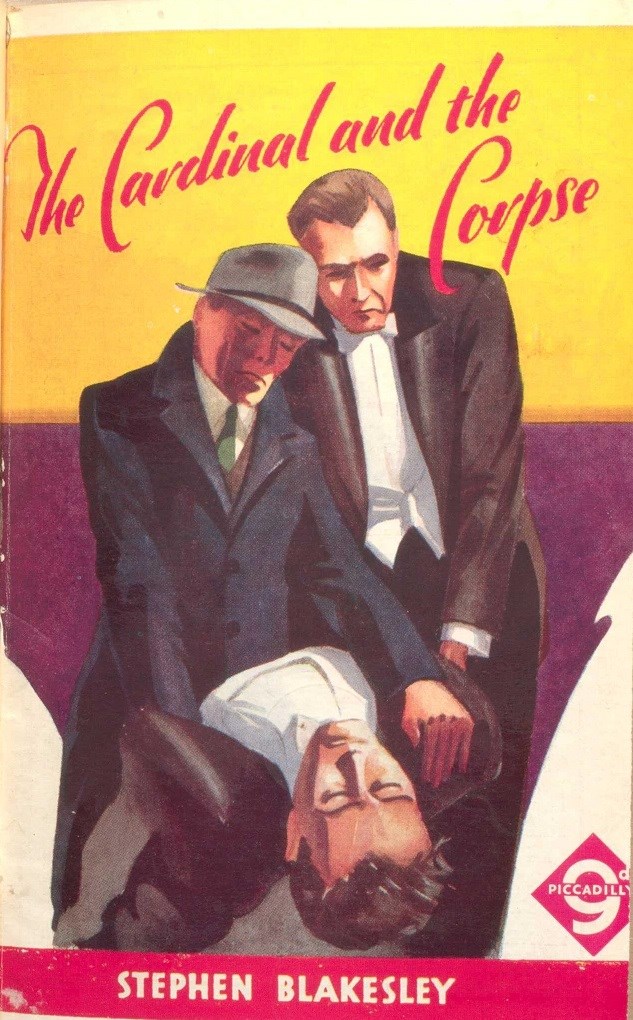The Cardinal & the Corpse

A Flanntasy in Several Parts by Pádraig Ó Méalóid.
The Cardinal and the Corpse, a 40-minute semi-documentary made in 1992 by Christopher Petit and Iain Sinclair for a late-night slot on Channel 4, described quite accurately by one commentator as ‘a show about books and bibliophiles in London,’ muddied the pseudonymous O’Brien waters further. When I first watched it, I had no idea what was going on in The Cardinal and the Corpse, or who most of the people in it—with the exception of Alan Moore and British science fiction writer Michael Moorcock—were. It seemed to be another story with several beginnings, several different threads running through it, none of which I had the slightest understanding of.
[…]
Sexton Blake was a fictional detective who lived in Baker Street, as did Sherlock Holmes, and while in December 1893 The Strand Magazine was publishing Sir Arthur Conan Doyle’s The Final Problem—in which Holmes apparently fell to his death at the Reichenbach Falls—issue six of The Half-penny Marvel published The Missing Millionaire by Hal Meredeth, the very first appearance of Blake, the same month.
Sexton Blake worked as a consulting detective, had a sidekick called Tinker, a faithful hound called Pedro, and a bullet-proof Rolls-Royce, named The Grey Panther. He was a bit more of a physical detective than a cerebral one, though, and this may have been part of his appeal to his intended Penny Dreadful audience. Before long there were Sexton Blake stories—either stand-alone stories or serialised ones—appearing in The Half-penny Marvel, The Union Jack, and Pluck, and numerous others. Blake was hugely popular, and there have been something in the region of 4,500 stories written about him, by around two hundred writers, an awful lot of them under various pseudonyms and generic house names.
So, what evidence is there that Flann O’Brien wrote Sexton Blake stories? On the face of it, there appears to be lots of it, overwhelming amounts of it, actually, both from himself and others. First of all, there’s a letter he sent the then popular writer Ethel Mannin in July 1939, along with a copy of At Swim-Two-Birds. The correspondence, although brief, is in itself fascinating, with references to various side characters who may or may not have been mutual acquaintances of Flann and Mannin. Once she had read the book, though, Mannin didn’t like it, and said so, prompting the obviously thin-skinned Myles to write back to her, full of bluster, including these closing paragraphs,
It is a pity you did not like my beautiful book. As a genius, I do not expect to be readily understood but you may be surprised to know that my book is a definite milestone in literature, completely revolutionises the English novel and puts the shallow pedestrian English writers in their place. Of course I know you are prejudiced against me on account of the IRA bombings.
To be serious, I can’t quite understand your attitude to stuff like this. It is not a pale-faced sincere attempt to hold the mirror up and has nothing in the world to do with James Joyce. It is supposed to be a lot of belching, thumb-nosing and belly-laughing and I honestly believe that it is funny in parts. It is also by way of being a sneer at all the slush which has been unloaded from this country on the credulous English although they, it is true, manufacture enough of their own odious slush to make the import unnecessary. I don’t think your dictum about ‘making your meaning clear’ would be upheld in any court of law. You’ll look a long time for clear meaning in the Marx Brothers or even Karl Marx. In a key I am preparing in collaboration with Mr Kevin O’Connor, it is explained that the reader should begin on p. 145 and then start at the beginning when he reaches the end like an up-&-down straight in Poker. The fantastic title (which has brought a lot of fatuous inquiries to bird-fanciers) is explained on p. 95 and is largely the idea of my staid old-world publishers. My own title was ‘Sweeny in the Trees’. I am negotiating at present for a contract to write 6 Sexton Blake stories (25 to 30,000 words for £25 a time) so please do not send me any more sneers at my art. Sorry, Art.
Many things that would preoccupy O’Brien throughout his life are evident in that letter: his desire for literary acceptance, his preoccupation with money, his difficult relationship with James Joyce, and of course his strange obsession with Sexton Blake. O’Brien’s choice of Ethel Mannin as a possible champion of his work is certainly a strange one: her forté was mostly sentimental popular fiction with a left-leaning feminist tinge, very far from what AS2B was, and her liberal views—she had affairs with both W.B. Yeats and Bertrand Russell—hardly coincided with O’Brien’s own highly conservative Catholic worldview, or his evident misogyny.

[This is a short extract, the full article is available to read in Issue Three]
ABOUT THE AUTHOR
Pádraig Ó Méalóid lives in Dublin with his wife and cats. He gets called a comics historian a lot. He knows more about the British comic character Marvelman than anyone else on the planet, and once had a cup of tea made for him by Alan Moore, who he has been interviewing every few years for quite a while now. He has written for numerous publications, including The Beat and Forbidden Planet Blog, and has been killed off in various books by various writers, at his own request.
